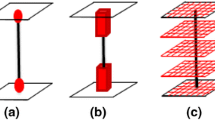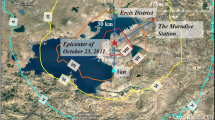Abstract
The paper conducts low-reversed cyclic loading tests on frame-supported ribbed-grid composite slab structures (FSRGCS structure) of different compositions. With the help of non-linear IDARC program, it establishes a calculation model specifically for the study, in which the hysteretic laws of Park’s degradation-parameter model is used. Afterwards, the experimental data collected are compared with the calculation results of the hysteretic curves and the skeleton curves, so as to verify the model established and to provide reference for future study of a similar structure. ANSYS software is applied in an effort to provide a detailed simulation of the force-bearing performance of the structure at the elastic-plastic stage, and the results arrived are found consistent with the experiment condition, which ensures an accurate forecast of stress distribution for the FSRGCS structure. Besides, the influence of any changes in the dimension and the location of holes on the seismic performance of the structure is analyzed.
Similar content being viewed by others
References
Ahmad, R. (2011). “Lateral stiffness of concrete shear walls for tall buildings.” Structural Journal, Vol. 108, No. 6, pp. 755–765, DOI: 10.14359/51684051.
Burton, H. and Deierlein, G. (2014). “Simulation of seismic collapse in nonductile reinforced concrete frame buildings with masonry infills.” Journal of Structural Engineering, Vol. 140, No. 8, pp. A4014016–1–10, DOI: 10.1061/(ASCE)ST.1943-541X.0000921.
Ding, Y. G. (2006). “Research on load-bearing performance and design method of frame-supported multi-ribbed wall beam.” Xi’an University of Architecture & Technology, Doctor Thesis of Engineering. (in Chinese), DOI: 10.7666/d.y970736.
Goulet, C. A., Haselton, C. B., Mitrani-Reiser, J., Beck, J. L., Deierlein, G. G., Porter, K. A., and Stewart, J. P. (2007). “Evaluation of the seismic performance of a code-conforming reinforced-concrete frame building -from seismic hazard to collapse safety and economic losses.” Earthquake Engineering and Structural Dynamics, Vol. 36, No. 13, pp. 1973–1997, DOI: 10.1002/eqe.694.
JGJ/T275-2013 (2014). “Directive rules for ribbed-Grid composite slab structure.” China Architecture & Building Press, Beijing, China (in Chinese), DOI: https://doi.org/doc.mbalib.com/view/a9bbdd595fd0beeefd4d2b32977561b9.html.
Jia, S. Z., Cao, W. L., and Yuan, Q. (2015). “An experimental study of frame-supported multi-ribbed composite walls.” Advances in Structural Engineering, Vol. 18, No. 4, pp. 497–511, DOI: 10.1260/1369-4332.18.4.497.
Jia, S. Z., Cao W. L., Yuan, Q., and Zhang, Y. C. (2016b). “Experimental study on frame-supported multi-ribbed composite walls under lowreversed cyclic loading.” European Journal of Environmental and Civil Engineering, Vol. 20, No. 3, pp. 314–331, DOI: 10.1080/19648189.2015.1036126.
Jia, S. Z., Cao, W. L., and Zhang, Y. C. (2017). “Damage index calibration of frame-supported concealed multi-Ribbed wall panels with energy-efficient blocks.” Applied Sciences-basel, pp.1–14, DOI: 10.3390/app7050453.
Jia, S. Z., Cao W. L., Zhang, Y. C., and Yuan Q. (2016a). “Analysis on stiffness ratio at interim layer of frame-supported multi-ribbed lightweight slab under low-reversed cyclic loading.” Applied Sciencesbasel, Vol. 6, No. 1, pp. 1–19, DOI: 10.3390/app6010021.
Jia, S. Z. and Yuan, Q. (2012). “Seismic response analysis of multiribbed composite wall structure subjected to near-fault ground motions.” Journal of Harbin Engineering University, Vol. 33, No. 1, pp. 1366–1370 (in Chinese), DOI: 10.3969/j.issn.1006-7043.201110035.
Jia, S. Z. and Yuan, Q. (2013). “Deteriorating hysteretic parameters and energy dissipation performance of multi-ribbed composite wall structures.” Journal of Huazhong University of Science and Technology, Vol. 41, No. 7, pp. 32–35 (in Chinese), DOI: 10.13245/j.hust.2013.07.025.
Kakaletsis, D. J. and Karayannis, C. G. (2008). “Influence of masonry strength and openings on infilled R/C frames under cycling loading.” Journal of Earthquake Engineering, Vol. 12, No.2, pp. 197–221, DOI: 10.1080/13632460701299138.
Kakaletsis, D. J. and Karayannis, C. G. (2009). “Experimental investigation of infilled reinforced concrete frames with openings.” Structural Journal, Vol. 106, No. 2, pp. 132–141, DOI: https://doi.org/www.researchgate.net/publication/261757805.
Kaushik, H. B., Rai, D. C., and Jain, S. K. (2009). “Effectiveness of some strengthening options for masonry-Infilled RC frames with open first story.” Journal of Structural Engineering, Vol. 135, No. 8, pp. 925–937, DOI: 10.1061/(ASCE)0733-9445(2009)135:8(925).
Kunnath, S. K., Reinhorn, A. M., and Abel, J. F. (1992). “A computational tool for seismic performance of reinforced concrete buildings.” Computers and Structures, Vol. 41, No. 1, pp. 157–173, DOI: 10.1016/0045-7949(91)90165-I.
Kunnath, S. K., Reinhorn, A. M., and Park, Y. J. (1990). “Analytical modeling of inelastic seismic response of R/C structures.” Journal of Structural Engineering, Vol. 116, No. 4, pp. 996–1017, DOI: 10.1061/(ASCE)0733-9445(1990)116.
Li, B. X., Xie, H. P., Deng, J. H., He, C. R., and Wang, Z. (2009). “Characteristic analysis of performance and damage of buildings in Wenchuan Earthquake and considerations in aseismic design of buildings.” Journal of Disaster Prevention and Mitigation of Engineering, Vol. 29, No. 2, pp. 224–230 (in Chinese), DOI: 10.15961/j.jsuese.2009.04.020.
Li, S. C., Dong, J. X., and Li, L. F. (2012). “Experimental hysteretic behavior of in-plane loaded reinforced grouted multi-ribbed aerated concrete blocks masonry walls.” Structural Engineering and Mechanics, Vol. 41, No. 1, pp. 95–112, DOI: 10.12989/sem.2012.41.1.095.
Li, S. C., Jiang, L. L., and Yu, Q. R. (2002). “Shear-resistant behavior analysis on light composite shear wall.” Tsinghua Science and Technology, Vol. 7, No. 6, pp. 560–566, DOI: https://doi.org/www.cnki.com.cn/Article/CJFDTOTAL-QHDY200206001.htm.
Liu, P. and Guo, M. (2012). “An experimental study of multi-grid composite walls.” Advances in Structural Engineering, Vol. 15, No. 3, pp. 495–507, DOI: 10.1260/1369-4332.15.3.495.
Liu, P. and Yao, Q. F. (2010). “Dynamic reliability of structures: the example of multi-ribbed composite walls.” Structural Engineering and Mechanics, Vol. 36, No. 4, pp. 463–479, DOI: 10.12989/sem.2010.36.4.463.
Miao, Z. W., Ye L. P., Guan H. and Lu, X. Z. (2011). “Evaluation of modal and traditional pushover analyses in frame-shear wall structures.” Advances in Structural Engineering, Vol.14, No. 5, pp. 815–836, DOI: 10.1260/1369-4332.14.5.815.
Mondal, G. and Jain, S. K. (2008). “Lateral stiffness of masonry infilled Reinforced Concrete (RC) frames with central opening.” Earthquake Spectra, Vol. 24, No. 3, pp. 701–723, DOI: 10.1193/1.2942376.
Mostaghel, N. (1999). “Analytical description of pinching, degrading hysteretic systems.” Journal of Engineering Mechanics, Vol. 125, No. 2, pp. 216–224, DOI: 10.1061/(ASCE)0733-9399(1999)125:2(216).
Pang, N. Y. and Jia, Y. J. (2012). “Analysis of factors influencing performance of frame-supported multi-ribbed wall beam under vertical load[J].” Industrial Construction, Vol. 42, No. 2, pp. 54–57(in Chinese), DOI: 10.13204/j.gyjz2012.02.023.
Park, Y. J. and Ang, A. H. S. (1985). “Mechanistic seismic damage model for reinforced concrete.” Journal of Strctural Engineering, Vol. 111, No. 4, pp. 722–739, DOI: https://doi.org/www.docin.com/p-521844221.html.
Ribeiro, F., Barbosa, A., Scott, M., and Neves, L. (2014). “Deterioration modeling of steel moment resisting frames using finite-length plastic hinge force-based beam-column elements.” Journal of Structural Engineering, Vol. 141, No. 2, DOI: 10.1061/(ASCE)ST.1943-541X.0001052.
Simeonov, V. (1999). Three-dimensional inelastic dynamic structural analysis of frame systems, PhD dissertation, State University of New York at Buffalo, Buffalo, N.Y., DOI: https://doi.org/trove.nla.gov.au/version/50806770.
Sivaselvan, M. and Reinhorn, A. M. (2000). “Hysteretic models for deteriorating inelastic structures.” Journal of Strctural Mechanics, Vol. 126, No. 6, pp. 633–640, DOI: 10.1061/(ASCE)0733-9399(2000).
Wang, C., Foliente,G.C., Sivaselvan, M. V., and Reinhorn, A. M. (2001). “Hysteretic models for deteriorating inelastic structures.” Journal of Engineering Mechnics, Vol. 127, No. 11, pp. 1200–1222, DOI: 10.1061/(ASCE)0733-9399(2001)127:11(1200).
Wei, X. (2008). Study on mechanics and seismic design of multi-ribbed composite wall structure with frame at the bottom, Doctor Thesis of Engineering (in Chinese), Xi'an University of Architecture and Technology, DOI: 10.7666/d.y1339545.
Xia, L. (2010). Study on composite action effect and non-linear analysis method of multi-ribbed composite wall structure with frame at the bottom, Doctor Theis of Engineering (in Chinese), Beijing jiaotong University, DOI: https://doi.org/d.wanfangdata.com.cn/Thesis/Y2220394.
Yao, Q. F., Hou, L. N., Huang, W., and Lu, Z. F. (2008). “Equivalent oblique compression bar model of multi-ribbed composite wall.” Industrial Construction, Vol. 38, No. 1, pp. 4–8 (in Chinese), DOI: 10.13204/j.gyjz2008.01.002.
Yuan, Q., Liu, H. T., Wang X. L., and Zhao, Y. Y. (2013). “Research and verification of numerical analysis model of multi-ribbed composite slab structures.” Journal of Building Structures, Vol. 34, No. 5, pp. 151–157 (in Chinese), DOI: 10.14006/j.jzjgxb.2013.05.018.
Zhao, B., Fabio, T., and Tiziana, R. (2009). “Field investigation on the performance of building structures during the 12 May 2008 Wenchuan earthquake in China.” Engineering Structures, Vol. 31, No. 8, pp. 1707–1732, DOI: 10.1016/j.engstruct.2009.02.039.
Author information
Authors and Affiliations
Corresponding author
Rights and permissions
About this article
Cite this article
Suizi, J., Wanlin, C., Yuchen, Z. et al. Simplified Calculation Model and Finite-element Analysis of Frame-supported Ribbed-Grid Composite Slab Structure. KSCE J Civ Eng 22, 3383–3394 (2018). https://doi.org/10.1007/s12205-017-0457-5
Received:
Revised:
Accepted:
Published:
Issue Date:
DOI: https://doi.org/10.1007/s12205-017-0457-5




